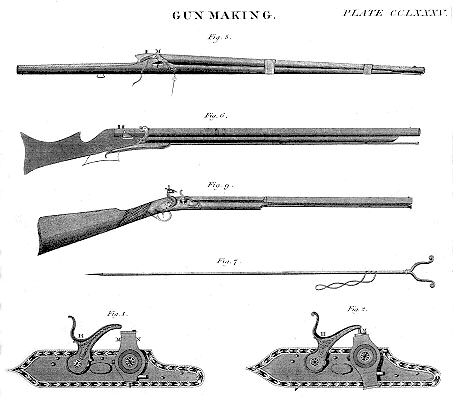Interchangeable Parts
Today, a brilliant invention is forgotten. The University of Houston's College of Engineering presents this series about the machines that make our civilization run, and the people whose ingenuity created them.
Manufacturing with machine-made, interchangeable parts isn't the same as the modern assembly line. Interchangeability had to be well developed before we could begin mass-producing goods. The idea of interchangeability goes back to Gutenberg's invention of precision type. Clock-makers had started making certain parts interchangeable in the 18th century. And Americans like to credit Eli Whitney with inventing the idea in 1803 to make muskets.
But, for the first whole product whose parts could be interchanged, historian Ken Alder takes us to Paris in 1790 [1]. Gunsmith Honoré Blanc had made a thousand muskets and put all their parts in separate bins. He called together a group of academics, politicians, and military men. Then he assembled muskets from parts drawn at random from the bins. By then, Jefferson had already visited Blanc's workshop and written back to America about the method.
Jefferson was president when Eli Whitney duplicated Blanc's demonstration 18 years later. No one realized it then, but Whitney was faking it. He'd carefully hand-crafted each part so they'd fit together. Whitney sold the government a huge contract for four thousand muskets. He took eight years to deliver them and then the parts weren't interchangeable after all.
But other Americans went on to make the method work. Before the Civil War, we had rifles with parts that could be swapped. After the war, we began making complex merchandise like sewing machines and typewriters with interchangeable parts.
So what became of Blanc and his method? The answer's a surprise. For one thing, Blanc wasn't first to make muskets this way. Various French makers had worked on the idea since 1720. Furthermore, Blanc went into business and, by the time Whitney made his demonstration, Blanc was producing 10,000 muskets a year for Napoleon.
Then, in 1806, the French government sacked the whole process. Why? By using unskilled labor, Blanc's method had made manufacturers independent of government control over the old crafts. The government raised the arcane argument that workers who don't function as a whole can't produce harmonious products. They simply declared that Blanc's method wasn't working and they scrapped it.
Meanwhile, America built upon Whitney's scam. By 1850, English visitors back from America described what they now called the American System of Manufacture. When they told the French about the use of interchangeable parts, they found the French military had never even heard of it. The French had buried it that completely!
The story grimly reminds us that technology does not progress in simple logical ways. Our choices depend on a hundred subjective matters, and they are only thinly influenced by what works best.
I'm John Lienhard, at the University of Houston, where we're interested in the way inventive minds work.
(Theme music)
1. Alder, K., Innovation and Amnesia: Engineering Rationality and the Fate of Interchangeable Parts Manufacturing in France. Technology and Culture, Vol. 38, No. 2, April 1997, pp. 273-311.
An early Engines program, Episode 101, also deals with the invention of manufacturing with interchangeable parts.

Early 19th-Century Gun-Making.
Drawing source: Edinburgh Encyclopaedia, 1832